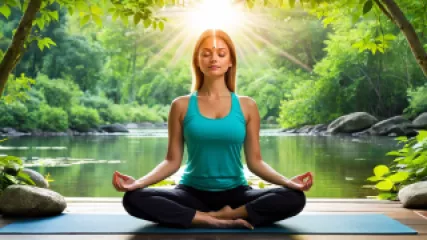Top 5 Mental Wellness Techniques for Relaxation
Top 5 Mental Wellness Techniques for Relaxation
In today's fast-paced world, finding ways to unwind and reduce stress has become increasingly important for our overall well-being. Mental wellness is a crucial aspect of our health, and incorporating relaxation techniques into our daily lives can have a profound impact on our ability to manage stress, improve focus, and enhance our quality of life. In this article, we'll explore the top 5 mental wellness techniques that can help you find a deeper sense of calm and relaxation.
1. Mindfulness Meditation
Mindfulness meditation is a powerful practice that involves focused attention on the present moment, without judgment or attachment. By cultivating a non-reactive awareness of our thoughts, emotions, and physical sensations, we can learn to navigate the ups and downs of life with greater ease and clarity. Jeremiah Sharp, a certified mindfulness coach, explains the benefits of this technique:
"Mindfulness meditation helps us to break free from the constant chatter of our minds and reconnect with the present moment. When we're fully engaged with the here and now, we're able to experience a profound sense of inner peace and clarity. This not only reduces stress and anxiety, but also enhances our ability to make better decisions and respond more skillfully to the challenges we face."Jeremiah Sharp
To begin a mindfulness meditation practice, find a quiet and comfortable space, and set aside 10-20 minutes each day. Start by focusing on your breath, noticing the sensations of the air moving in and out of your body. If your mind wanders, gently bring your attention back to your breath. With regular practice, you'll find that your ability to stay present and focused will improve, leading to a greater sense of calm and relaxation.
2. Yoga and Breathwork
Yoga and breathwork are powerful tools for promoting mental wellness and relaxation. The physical postures, or asanas, of yoga help to release tension and stress from the body, while the focus on conscious breathing encourages a state of deep relaxation. Raegan Anderson, a yoga instructor and breath specialist, explains the impact of these practices:
"Yoga and breathwork work together to create a powerful synergy that calms the mind and body. The physical movements of yoga help to release muscle tension and improve flexibility, while the conscious control of the breath triggers the parasympathetic nervous system, which is responsible for rest and digestion. This combination can lead to a profound sense of relaxation and inner peace."Raegan Anderson
To incorporate yoga and breathwork into your mental wellness routine, start with simple poses like child's pose, forward folds, and gentle twists. Focus on your breathing, taking slow, deep inhalations and exhalations. You can also try different breathing techniques, such as box breathing or alternate nostril breathing, to further enhance the relaxation response.
3. Guided Imagery and Visualization
Guided imagery and visualization are powerful mental wellness techniques that can help to reduce stress and promote relaxation. These practices involve the use of the imagination to create vivid mental pictures or scenarios that can have a calming effect on the mind and body. Yong Graham, a licensed therapist and guided imagery specialist, explains the benefits of this approach:
"Guided imagery and visualization allow us to tap into the power of our imagination to create a sense of calm and well-being. By visualizing peaceful, soothing scenes or images, we can activate the brain's reward and pleasure centers, leading to a reduction in stress hormones and an increase in feel-good neurotransmitters like serotonin and dopamine. This can have a profound impact on our mental and emotional state."Yong Graham
To try guided imagery, find a quiet and comfortable space, close your eyes, and begin to imagine a peaceful, calming scene. It could be a serene beach, a lush forest, or a cozy cottage – whatever evokes a sense of tranquility for you. Engage all of your senses by visualizing the details of the scene, such as the colors, textures, sounds, and smells. Breathe deeply and allow yourself to fully immerse in the experience. With regular practice, you'll find that this technique can help to transport you to a state of deep relaxation and inner calm.
4. Progressive Muscle Relaxation
Progressive muscle relaxation is a technique that involves systematically tensing and releasing different muscle groups in the body, with the goal of achieving a deep state of physical and mental relaxation. Miriam Rogers, a licensed physical therapist and stress management expert, explains how this technique works:
"Progressive muscle relaxation helps to reduce muscle tension and stress by teaching us to consciously control the contraction and release of our muscle groups. By focusing on the sensations of tension and release, we can become more attuned to the physical manifestations of stress in our bodies, and learn to consciously counteract them. This not only helps to alleviate physical discomfort, but also has a calming effect on the mind."Miriam Rogers
To practice progressive muscle relaxation, start by lying or sitting in a comfortable position. Slowly tense each muscle group, holding the tension for a few seconds, and then release the muscle, allowing it to relax completely. Work your way through the major muscle groups, from your toes to your head, focusing on the sensations of tension and release. With regular practice, you'll find that this technique can help to melt away stress and promote a deep sense of relaxation.
5. Nature-Based Therapy
Spending time in nature has been shown to have a profound effect on our mental well-being and stress levels. Nature-based therapy, also known as ecotherapy, is a holistic approach to mental wellness that harnesses the healing power of the natural world. Jeremiah Sharp explains the benefits of this practice:
"Immersing ourselves in nature, whether it's taking a hike in the woods, gardening, or simply spending time in a park, can have a transformative effect on our mental health. The combination of physical activity, sensory engagement, and the calming presence of the natural environment can help to reduce stress, improve mood, and foster a greater sense of overall well-being."Jeremiah Sharp
To incorporate nature-based therapy into your mental wellness routine, try to spend at least 30 minutes a day in a natural setting, such as a park, forest, or garden. Pay attention to your senses, noting the sights, sounds, smells, and textures of the environment. You can also engage in activities like hiking, gardening, or simply sitting and observing the natural world around you. With regular practice, you'll find that this connection with nature can have a profound impact on your mental and emotional health.
In conclusion, the top 5 mental wellness techniques for relaxation – mindfulness meditation, yoga and breathwork, guided imagery and visualization, progressive muscle relaxation, and nature-based therapy – offer a comprehensive approach to promoting inner calm and well-being. By incorporating these practices into your daily routine, you can learn to better manage stress, improve focus, and enhance your overall quality of life.
Remember, the key to finding the right relaxation technique for you is to experiment and find what works best for your individual needs and preferences. Be patient and persistent, and allow yourself the time and space to fully engage with these practices. With regular practice, you'll find that these mental wellness techniques can become powerful tools for achieving a greater sense of inner peace and balance.






